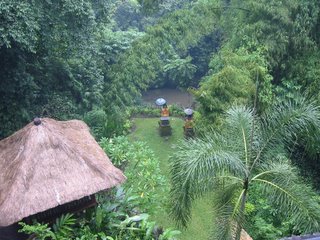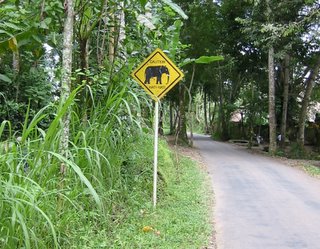
One of my favorite things about travel, as I explained in my Morocco blogs (
here and
here) is eating. I love trying new and exotic foods, especially natural, healthy stuff that so many traditional societies are still into. Wait 'til I write about the eats in Thailand, but even from what I wrote about
food in Sri Lanka, you probably could guess that spicy, tropical foods turn me on big time. And Bali and I were made for each other!
I had never been to Indonesia when Rebecca, Brad, Craig and I went to Bali last spring. But, though Indonesian cuisine is not that well known in the U.S. yet, I spent nearly 4 years living in Amsterdam, where Indonesian restaurants are as common as Chinese restaurants are here. And, with lots of vegetarian specialities and delicious and subtle-- and not so subtle-- spices, I was always a big fan. But there's another reason I might not be a perfect tour guide to the intricacies of Balinese cuisine. Almost all my breakfasts, lunches and dinners were prepared by the incredible Wayan, a first class chef who "came with"
the villa we rented. So the kind of restaurant tour guide I'm planning to write for Bangkok isn't going to translate that well for Bali. On the other hand, in
all cultures, the best food is fresh, home-cooked food-- and fresh home-cooked food is all I ever ate in Bali.
Don't get me wrong; if you want the worst and most unhealthy garbage man has ever eaten in history, you can find it in Bali: Burger King, McDonald's, Pizza Hut, Kentucky Fried... that crap is all crowded into the tourist ghettos down south in the relatively hideous sprawl of Kuta, Sanur, Legian and more up-market Jambaran. And Balinese restaurants
per se don't actually exist. Eating out is note a balinese custom. There are Javanese and Chinese restaurants and restaurants in general-- at least in the way we think of restaurants in the West-- really are just for (wealthy; if you got there, you're wealthy by south Asian standards) tourists. The Balinese eat mostly at home. The Javanese and other Indonesians who live and work on Bali eat in padangs (Sumatran restaurants that serve lots and lots of very spicy small dishes like tapas and only charge you for what you eat) and warungs (a small roadside eating stall/coffee-shop-gossip place) and in night markets.
Before we left for L.A. I faxed Wayan my dietary complexities-- fresh vegetables, fruits and fish, no sugar, no canned stuff, nothing made with flour and light on the #1 staple of Balinese eating: rice-- and only brown rice at that. Seemingly effortlessly she was able to adapt that to traditional Balinese and Indonesian cuisine. The food she served, three meals a day, was always astounding delicious, as well as healthy. I can barely remember all the delicious new fruits she introduced me to at breakfast everyday: jackfruit (which I couldn't get enough of-- especially cooked in savory dishes), campedak (which is I think what pirates referred to as breadfruit), mangosteens (my favorite of all, something that I still dream about), rambutan, sakaya, durian (a delicious but smelly fruit I remember from my days in India), snake-fruit, starfruit... as well as lots of more familiar things like mangos and papayas and oranges pineapples, bananas... Breakfast was always such a joy in the incredible dining room open to the world, overlooking the Ayung river, birds singing away. Balinese life is very integrated with the outdoors. It took me-- insect-phobe that I am-- about 2 minutes to get over all my retiscence and embrace it completely. Every day after breakfast I would sit down with Wayan and go over the two cook books (with color pictures) she has, one for Balinese cuisine and one for Indonesian cuisine and pick out dishes for lunch and dinner. Then she'd go shopping.
Indonesian cuisine, which is more sophisticated than Balinese cooking, has obvious influences from India, China, the Middle East-- Indonesia is overwhelmingly Muslim, although Bali is a majority Hindu island-- and even Europe and Japan. The food tends to be spicy-- and unless you make it clear that you don't want it that way--
very spicy. I like the "very" part. Rice (
nasi) is the center of most meals, although I did fine without it.
Nasi goreng and
nasi campur are, respectively, fried and plain rice mixed with... whatever. Sate is a big deal too-- grilled, skewered meat or shrimps dipped in delicious spicy peanut sauce.
Gado-gado is something almost anyone will love-- vegetables smothered in peanut sauce.
It was tempting to eat every single meal in the house because I was sure no one would come close to Wayan's meals, not to mention the fact that I knew everything would be healthy. But, of course, I had to try a couple restaurants, right?
My instincts were right. Home cookin' is always better! And Wayan is even better than most home cooking! There's no way we weren't going to try the restaurant that is supposed to be the best in Bali,
Mozaic in Ubud. The chef is Chris Salans from the French Laundry in the Napa Valley, a spectacular restaurant. The patio-dining environment was exquisite and the food-- perhaps the best restaurant food in Bali-- was good... but not even
close to Wayan's. And Mozaic is
really expensive! We also tried the Cafe Lotus, a longtime tourist classic in the center of Ubud. It was ok-- just tourist food though. So in Bali too... there's no place like home!











